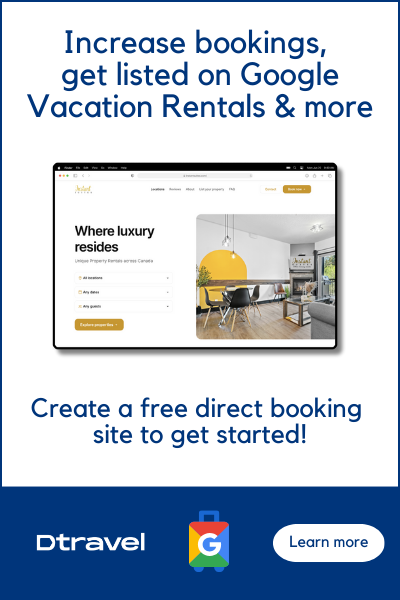Making your short-term rental more accessible isn’t an all-or-nothing proposition. Small changes – that cost $100 or less – can literally open your doors to a whole new pool of potential guests.
Increasing the accessibility of your home isn’t just the right thing to do; it’s a wise business decision when you consider that 61 million American adults have a disability, according to the Centers for Disease Control.
Less than 6% (3.6 million) of people with disabilities report being homebound due to their disabilities, according to the U.S. Department of Transportation. That means the other 94% are potential guests.
Despite the large potential market, the availability of accessible short-term rentals is comparably scarce, said Lorraine Woodward, founder of Becoming rentABLE, a growing accessible property directory and education platform that promotes increasing the availability of accessible STRs. Twenty-three states have zero accessible short-term rental listings, according to an audit by Becoming rentABLE.
Much of the lack of accessibility stems from a lack of awareness rather than financial barriers, Lorraine said. In some cases, making your short-term rental more accessible could mean just looking at what you already have through the lens of someone with a disability. Here are eight low-cost ideas to help you make your property more accessible and welcoming.
1. Keyless locks, $100 and up
About 69% of short-term rental owners and property managers already use keyless locks as a matter of convenience, according to the 2022 State of the STR Community Report.
But did you know that keyless locks, when positioned correctly, also make your short-term rental more accessible to people with disabilities, especially those with muscle weakness or dexterity issues? Becoming rentABLE advises mounting numeric keypads at door-level height to make them easy to reach for people in wheelchairs.
2. Door levers, $40 and up
While you’re changing out your keyed locks to keyless locks, it would be most economical to replace your entryway doorknob with a door lever at the same time. Keyless locks and door levers often come bundled and go for a lower price when purchased together.
Door levers like this and this are much easier to turn than traditional door knobs for people with dexterity problems and muscle weakness. Start with the entryway and then consider replacing all of your doorknobs throughout the property with door levers. The cost of door levers for closets, bedrooms, and bathrooms usually runs between $10 and $25.
3. Expandable door hinges, $2 to $25
Who would have thought that a $2 to $25 investment would literally open your short-term rental to a whole new base of guests? Investing in expandable door hinges can do that for you, Lorraine said.
Approximately 4.8 million Americans rely on a walker and 1.4 million Americans rely on a wheelchair for mobility, according to the National Center for Health Statistics. Expandable door hinges provide an extra 2 inches of clearance in a doorway to allow barrier-free access for a walker or wheelchair, she said.
4. Paint color, $15 to $50
One in 44 children is diagnosed with autism spectrum disorder (ASD), according to the CDC. Given this high prevalence, decorating your home with ASD sensitivities in mind could open your short-term rental property to a treasure trove of new renters.
In addition to light and sound sensitivities, many children with autism are overstimulated by certain colors. For instance, children with autism can perceive red as a fluorescent color and become agitated. It’s best to choose neutral colors to reduce visual stimulation. Here’s a guide to choosing paint colors with ASD in mind.
5. Vibrating alarm clock, $20 to $60
About 15% of American adults, not counting children, have some type of hearing problem, according to the National Institute of Deafness and Communication Disorders.
A vibrating alarm clock is an easy, low-cost way to take these 37.5 million adults into consideration at your short-term rental. Simple and easy to use, vibrating alarm clocks have an attachment that shakes the bed to wake up those with hearing loss or guests who are just heavy sleepers.
6. Shower chair, $50 or less
Guests who use a wheelchair, have muscle weakness, or experience difficulty or pain when standing may need to sit down for a shower. Shower chairs are typically lightweight and foldable, so you can choose to either mount the chair in the shower or make it portable.
7. Handheld shower head with adjustable slide bar, around $100
A handheld showerhead with an adjustable slide bar complements a shower chair. This low-cost attachment is as easy to install as an ordinary shower head but makes showering safer for many people with disabilities.
8. Raised toilet seat, $60 or less
A raised toilet seat makes it easier for people in wheelchairs and others with mobility issues to sit down. Installing a raised toilet seat requires about the same amount of effort as installing an ordinary toilet seat.
Sometimes making your short-term rental more accessible is just a state of mind. Start looking at ways you can slowly make improvements and perhaps even focus your upgrades on making your home more accessible to people with a specific kind of disability.
Your short-term rental can’t be everything to everyone, but it can be a special getaway for someone who might have previously struggled to find accessible accommodations.
For more tips on how to make your short-term rental more accessible, to market your accessible short-term rental to people with disabilities, or to find an accessible short-term rental, visit BecomingrentABLE.com.
Editor’s Note: The products linked in this article are for example purposes only and are not reviewed or endorsed by Rent Responsibly. Prices may vary.
•••
SUBSCRIBE TO GET UPDATES


